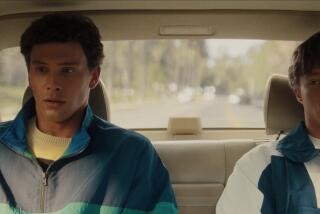Monster smash
- Share via
“HEAR my tale,” Frankenstein’s monster begs his creator. “It is long and strange.” In her cultural history of our favorite monster, Susan Tyler Hitchcock shows that the story is longer and stranger than the creature or Victor Frankenstein or even Mary Shelley could ever have imagined. The unloved horror has now been flourishing for almost 200 years. The response to it has ranged from early 19th century stage adaptations to “The Rocky Horror Picture Show,” from John Tenniel’s cartoons to our own era’s cautionary sermons about genetic engineering.
Hitchcock’s journey down the murky back alleys of this saga began one Halloween at the University of Virginia, when she was scheduled to teach Shelley’s novel in her literature class and wore a “lurid green face mask” to school. A surprisingly lively discussion resulted, with the students finding themselves both more familiar with and more ignorant about “Frankenstein” than they knew. The teacher too realized how fascinating she found the topic and how much more she had to learn. She has fulfilled her ambition: Her text grows out of such a fertile ground of scholarly research that any chapter might blossom into another volume.
Thus it’s all the more remarkable that this book is so much fun. Consider the guests who crowd into this name-dropper’s paradise of a party: Mary and Percy Shelley, Lord Byron, James Whale, Elsa Lanchester, Boris Karloff, Gene Wilder, Susan Sontag, Robert De Niro. Oh, and don’t overlook that campy fellow Frank-N-Furter warbling in the corner. (“Science fiction double feature / Doctor X will build a creature. . . . “)
At a real party, in a conversation about “Frankenstein,” any two people may disagree not only about the story’s implications but even its contents. There are two “Frankensteins” lurking out there -- the (anonymous) 1818 first edition and the revised version of 1831. Hitchcock details how and why they differ. In the 1818 edition, young Mary Wollstonecraft Godwin, expatriate daughter of radical activists and mistress of a married poet, boldly states her thoughts and imaginings. Her monster reads books, among them Milton’s “Paradise Lost,” and Victor Frankenstein’s fiancée is his cousin, a hint of incest perhaps unwise from an author who would survive so many Byron-era scandals. In 1831, for the official version bearing her married name, she drastically tones down the ambiguities. A famous author and now the widow of a poet whose reputation hints at staying power, she has Frankenstein mouth moralistic platitudes (at one point, he hopes a listener will “deduce an apt moral” from his account of his hubris), and his creation is far more monstrous and bloodthirsty.
One of Hitchcock’s themes is the attempt of almost everyone who has adapted “Frankenstein” into another medium to clarify its presumed moral. Each new interpreter, it seems, feels bound to denounce as sacrilege Frankenstein’s ambition to create life. Shelley originally intended a more ambivalent, classical slant, as indicated by her subtitle, “The Modern Prometheus.”
There’s no more of a critical consensus on “Frankenstein” than on most influential novels. “This Tale is evidently the production of no ordinary Writer,” an early review conceded. Another complained that the “three spirit-wearing volumes” of 1818 led “to no conclusion either moral or philosophical.” A third wondered whether the anonymous author’s head or heart “be the most diseased.” Reviewers have responded with similar discord to the parade of plays, movies, animated cartoons, toys and video games the story has inspired.
Inevitably, Hitchcock’s book surveys an entire genre. Moving gracefully from novel to film to metaphor, she spends little time theorizing. Her “cultural history” is so lively that at first you may decide it lacks scholarly ballast and slant. Soon, however, one sees that the author’s admirable restraint serves to advance and streamline the text. In the last chapters, while addressing how academic criticism opened the door to “Frankenstein,” Hitchcock’s own work confirms the value of cultural history as a discipline. By the 1970s, this awkward but visionary and insightful novel was in dire need of revisionism, feminist and otherwise. Not surprisingly, female critics added a new dimension of understanding to the text, including a close analysis of the birth fear saturating this tale of life and death, creation and destruction -- written, after all, by a twice-pregnant teenager.
The book’s illustrations are excellent. Early depictions of galvanism and polar expeditions set the scene. We see that a century ago “Frankenstein” was invoked in editorial cartoons to embody the fear that the United States, in its imperialist behavior, was aping its European ancestors. Later we glimpse the talking dogs in “Frankenweenie,” a 1984 Disney short made by a promising young director named Tim Burton. And, yes, Peter Boyle and Fred Gwynne are both here.
As Hitchcock’s excellent closing chapter, “The Monster and His Myth Today,” demonstrates, there’s no sign that “Frankenstein’s” broad appeal is diminishing. In the epoch of genetic engineering, the reanimated specter who first appeared in Mary Shelley’s dream is alive and well, still haunting our sense of who we are. *
More to Read
Sign up for our Book Club newsletter
Get the latest news, events and more from the Los Angeles Times Book Club, and help us get L.A. reading and talking.
You may occasionally receive promotional content from the Los Angeles Times.










